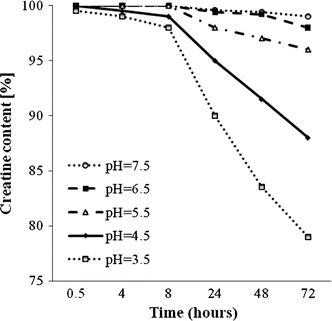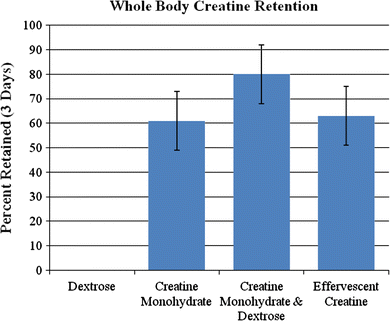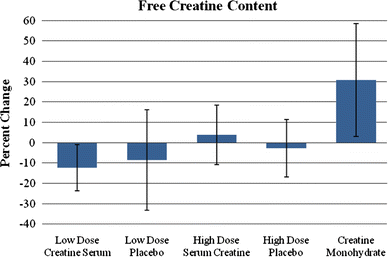Analysis of the efficacy, safety, and regulatory status of novel forms of creatine
- PMID: 21424716
- PMCID: PMC3080578
- DOI: 10.1007/s00726-011-0874-6
Analysis of the efficacy, safety, and regulatory status of novel forms of creatine
Abstract
Creatine has become one of the most popular dietary supplements in the sports nutrition market. The form of creatine that has been most extensively studied and commonly used in dietary supplements is creatine monohydrate (CM). Studies have consistently indicated that CM supplementation increases muscle creatine and phosphocreatine concentrations by approximately 15-40%, enhances anaerobic exercise capacity, and increases training volume leading to greater gains in strength, power, and muscle mass. A number of potential therapeutic benefits have also been suggested in various clinical populations. Studies have indicated that CM is not degraded during normal digestion and that nearly 99% of orally ingested CM is either taken up by muscle or excreted in urine. Further, no medically significant side effects have been reported in literature. Nevertheless, supplement manufacturers have continually introduced newer forms of creatine into the marketplace. These newer forms have been purported to have better physical and chemical properties, bioavailability, efficacy, and/or safety profiles than CM. However, there is little to no evidence that any of the newer forms of creatine are more effective and/or safer than CM whether ingested alone and/or in combination with other nutrients. In addition, whereas the safety, efficacy, and regulatory status of CM is clearly defined in almost all global markets; the safety, efficacy, and regulatory status of other forms of creatine present in today's marketplace as a dietary or food supplement is less clear.
Figures













Similar articles
-
A buffered form of creatine does not promote greater changes in muscle creatine content, body composition, or training adaptations than creatine monohydrate.J Int Soc Sports Nutr. 2012 Sep 13;9(1):43. doi: 10.1186/1550-2783-9-43. J Int Soc Sports Nutr. 2012. PMID: 22971354 Free PMC article.
-
Bioavailability, Efficacy, Safety, and Regulatory Status of Creatine and Related Compounds: A Critical Review.Nutrients. 2022 Feb 28;14(5):1035. doi: 10.3390/nu14051035. Nutrients. 2022. PMID: 35268011 Free PMC article. Review.
-
Creatine as nutritional supplementation and medicinal product.J Sports Med Phys Fitness. 2001 Mar;41(1):1-10. J Sports Med Phys Fitness. 2001. PMID: 11317142 Review.
-
Effects of creatine supplementation on performance and training adaptations.Mol Cell Biochem. 2003 Feb;244(1-2):89-94. Mol Cell Biochem. 2003. PMID: 12701815 Review.
-
Is there a rationale for the use of creatine either as nutritional supplementation or drug administration in humans participating in a sport?Pharmacol Res. 2000 Mar;41(3):255-64. doi: 10.1006/phrs.1999.0618. Pharmacol Res. 2000. PMID: 10675277 Review.
Cited by
-
A buffered form of creatine does not promote greater changes in muscle creatine content, body composition, or training adaptations than creatine monohydrate.J Int Soc Sports Nutr. 2012 Sep 13;9(1):43. doi: 10.1186/1550-2783-9-43. J Int Soc Sports Nutr. 2012. PMID: 22971354 Free PMC article.
-
Searching for a better formulation to enhance muscle bioenergetics: A randomized controlled trial of creatine nitrate plus creatinine vs. creatine nitrate vs. creatine monohydrate in healthy men.Food Sci Nutr. 2019 Oct 3;7(11):3766-3773. doi: 10.1002/fsn3.1237. eCollection 2019 Nov. Food Sci Nutr. 2019. PMID: 31763026 Free PMC article.
-
Community-Based Survey Exploring Use of the Dietary Supplement Creatine by Adult Non-Athletes.Nutrients. 2021 Jul 24;13(8):2529. doi: 10.3390/nu13082529. Nutrients. 2021. PMID: 34444689 Free PMC article.
-
Amino acids regulating skeletal muscle metabolism: mechanisms of action, physical training dosage recommendations and adverse effects.Nutr Metab (Lond). 2024 Jul 2;21(1):41. doi: 10.1186/s12986-024-00820-0. Nutr Metab (Lond). 2024. PMID: 38956658 Free PMC article. Review.
-
Pharmacokinetic Analyses of Liposomal and Non-Liposomal Multivitamin/Mineral Formulations.Nutrients. 2023 Jul 7;15(13):3073. doi: 10.3390/nu15133073. Nutrients. 2023. PMID: 37447400 Free PMC article. Clinical Trial.
References
-
- Abraham S, Jiang S (2005) Process for preparing a creatine heterocyclic acid salt and method of use US Patent
-
- Bessman SP, Mohan C. Phosphocreatine, exercise, protein synthesis, and insulin. In: DeDeyn PP, Maresceau B, Statin V, Qureshi IA, editors. Guanidino compounds in biology and medicine. London: John Libbey and Company; 1992. pp. 181–186.
Publication types
MeSH terms
Substances
LinkOut - more resources
Full Text Sources
Other Literature Sources

